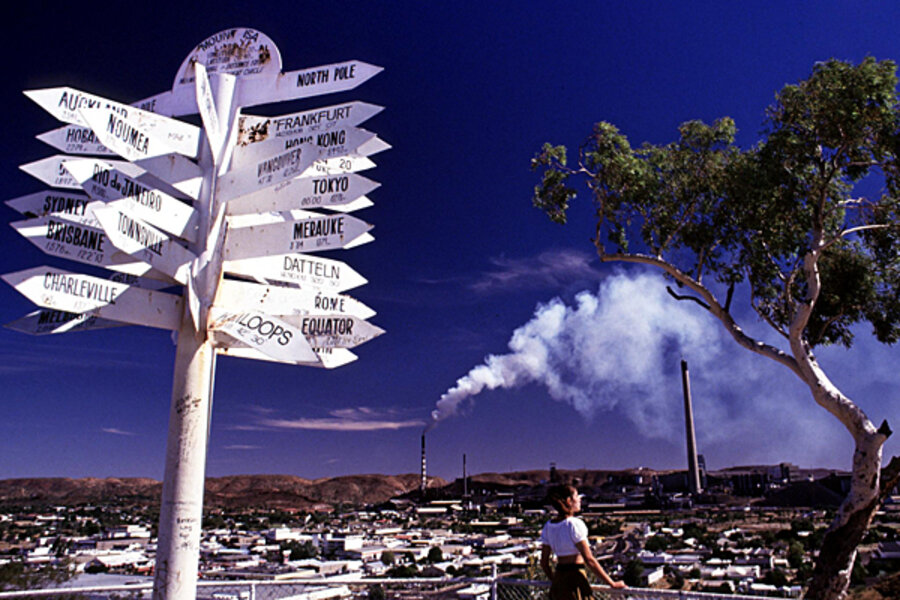Australian town confronts hidden costs of mining boom
Loading...
| Mount Isa, Australia
Daphne Hare moved to a small Queensland mining community, Mount Isa, in 2002, hoping for a share of the town’s prosperity. She found a job in a busy hotel, made friends, and settled down. But her infant daughter, Stella, frequently fell ill.
In 2008, after concerns were raised about the nearby lead mine, health officials offered a free blood-screening program for under-fives. Ms. Hare was horrified to discover that Stella had a blood lead reading well above World Health Organization (WHO) guidelines. And she was not alone: more than 1 in 10 children had potentially unsafe levels of the heavy metal in their systems.
Now Mount Isa is grappling with a dilemma facing many Australian communities: how to weigh the economic benefits of mining against possible adverse health effects. One of the world’s leading minerals exporters, the country is enjoying a prolonged mining boom that has underpinned the national economy. But some locals, subjected to lead, mercury, and other toxic emissions, believe they may be paying the price.
In Mount Isa, a mine and smelter that are Australia’s largest emitters of lead are situated next to a population of 23,000. The mine’s owner, the Anglo-Swiss giant Xstrata, suggests that exposed outcrops of naturally mineralized bedrock – rather than its operations – are the problem. That stance is backed by the Queensland government.
Hare was “in shock” following Stella’s blood test. “I would wake up crying in the night,” she says. The little girl’s reading then rose. Hare quit Mount Isa, but not before announcing plans to sue. Four other families have since joined her.
Extending blame to the government
The lawsuit names not only Xstrata, but also the city council and state government. The families’ lawyers allege that authorities knew about the risks for years but failed to protect the community.
Those risks – particularly to young children, in whom lead exposure can cause brain damage – have long been recognized. As a result, lead has been eliminated from paint and gasoline, at least in developed countries. But global demand for the metal, now used largely in lead-acid car batteries, remains high.
In Australia, major decontamination efforts have been undertaken in several of the half-dozen communities where lead is mined and smelted. That has yet to happen in Mount Isa, although alarm bells were rung by environmental health officers as far back as the 1980s. The council played down the dangers, according to internal documents seen by the Monitor, because it feared “the matter may … cause a panic.”
The current scare was triggered by Tim Powe, a senior manager with Queensland’s Environmental Protection Agency, who resigned after accusing the state government of neglecting public health. Special legislation exempts the Mount Isa mine from federal and state emissions limits, and Mr. Powe believes authorities were “scared to take on the company because it was one of the largest employers in the state.”
While his resignation led to the blood lead study, the source of the lead remains a controversy. Betty Kiernan, the local state representative, declared: “The reality is that lead is literally part of the foundations of our community.” John Piispanen, Queensland’s environmental health director, suggested that children might be ingesting lead from homemade fishing sinkers.
‘Don’t bite the hand that feeds you’
In other lead-reliant towns, such as Port Pirie in South Australia, the highlighting of health problems has divided residents. A similar schism has split Mount Isa, where many people – fiercely protective of their jobs – condemn those taking legal action. One mother, Louise Armstrong, says: “I didn’t get my kids tested, but I know they’re OK. I grew up here, and I haven’t got two heads.”
The litigants include Sharlene Body, whose four-year-old son, Sidney, had the highest blood lead reading of all, 31.5 mcg/dl. Mount Isa born and bred, Ms. Body observes: “They say, ‘Don’t bite the hand that feeds you.’ But what if that hand is poisoning you too?”
Sharnelle Seeto moved to Mount Isa in 2007. Her daughter, Bethany, recorded a sharply elevated blood lead reading; dust from the air-conditioning unit in her bedroom was found to contain 30 times the maximum safe limit set by the WHO for lead. “She was breathing that in,” says Ms. Seeto, incredulous.
Among those supporting the families is an eminent American professor of environmental toxicology, Russell Flegal. He has found higher concentrations of lead in Mount Isa’s soils than in notoriously polluted mining towns in China and Romania.
Xstrata defends its environmental record, calling its 15 air quality monitors around Mount Isa “the most intensive monitoring system in Australia.” The company’s environmental manager, Ed Turley, says fumes from the mine’s smokestacks are carried away by prevailing winds for much of the year, and at other times the smelters are shut down, to protect public health – which can happen during periods totaling about one tenth of the year.
But the families’ lawyer, Damian Scattini, brandishes photographs of dust clouds blowing from the mine site toward the town. Scattini is critical of official advice to minimize children’s lead exposure by washing their hands regularly. “If it was asbestos that was pouring into houses, what would people say?” he asks.
-----





